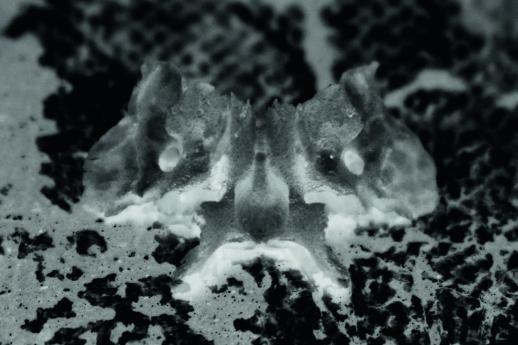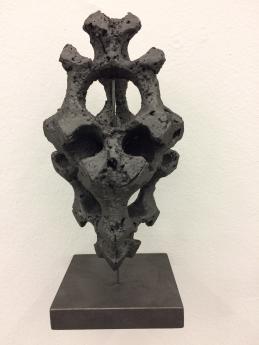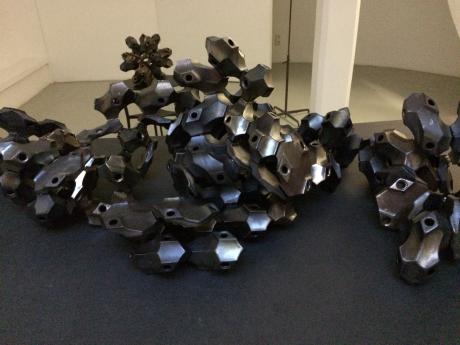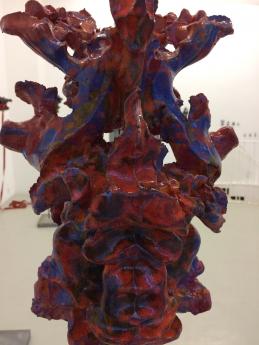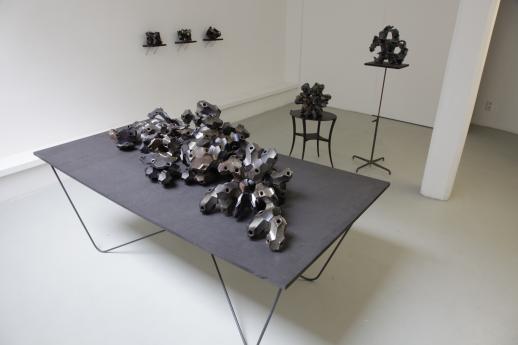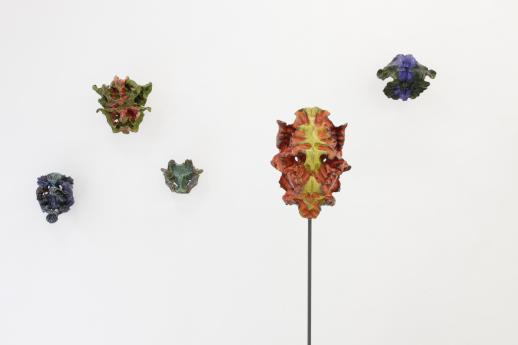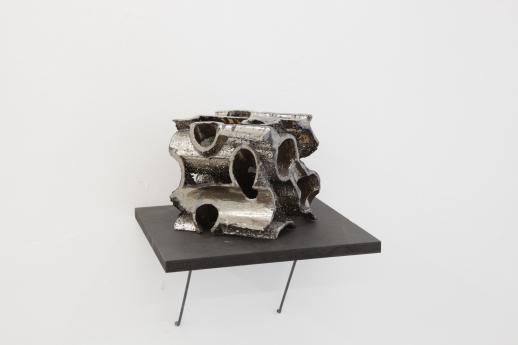Moritz Altmann
/
Megacities and the old gods
MEGACITIES AND THE OLD GODS ist die erste Ausstellung des Künstlers Moritz Altmann in der Galerie Francoise Heitsch. Bereits der Titel der Ausstellung verführt auf einen atmosphärischen Pfad. Megacities, ein Phänomen des 20. und 21. Jhd. stehen einer vagen Idee alter Gottheiten gegenüber. Den Moment des wuchernden urbane Raums, faktisch vorhanden und sachlich und ökonomisch als Phänomen diskutierbar verhandelt der Künstler in einem Atemzug mit der diffusen metaphysischen Instanz der „old gods“. Diese Nebeneinanderstellung scheinbar sehr gegensätzlicher struktureller Positionen findet sich auch in den Werken von Moritz Altmann wieder.
Während die Werke im oberen Ausstellungsraum vornehmlich von symmetrischen, fast anatomisch anmutenden Formen bestimmt sind, dominiert die Hauptwerke im unteren Raum eine repetitive und gleichmäßige Geometrie. Es liegt nahe, die maskenartigen Objekte aus glasierter, farbiger Keramik im oberen Raum der Ausstellung, der Welt der „old gods“ zuzuordnen. Sie könnten Referenz sein, diese Skulpturen, an kultische Objekte verschollener Kulturen, an Masken eines mythischen Theaters. Das Keramikobjekt in unteren Raum dagegen, ergibt sich, in seiner modularen Gleichartigkeit und doch jeweiligen Individualität seiner Teile, leicht als Verweis an eine technische Architektur moderner Urbanität.
Doch so punktuell, verschiedenartig und kleinteilig die Zitate von Moritz Altmann im jeweils einzelnen Werk auch zu entdecken sind, der Ausgangspunkt des Künstlers liegt in einer Ebene darüber. Es ist eine wiederkehrende Struktur und Ordnung der Dinge, die Moritz Altmann in seinen Werken verarbeitet. Er selbst beschreibt es als die Ornamentik verschiedener Systeme, der er nachspürt. Es sind also nicht die Tätsächlichkeiten möglicher Megacities oder eventueller Gottheiten, sondern wiederkehrende komplexe Strukturen, in denen sich die Welt zu organisieren scheint.
Damit betreibt Moritz Altmann eine hochspannende Arbeit zwischen künstlerischem Schaffen und künstlerischer Archäologie in der es von Analogien und vielleicht bewussten Zufälligkeiten wimmelt. Kein Wunder ist es da, wenn einzelne Werke gleichzeitig an anatomische Modelle, Masken und Baupläne futuristischer Maschinen erinnern. Der Künstler selbst vergleicht Städte mit Organismen und weiß von Pilzkulturen zu berichten, die sich wie ein U-Bahnnetz in die Fläche ausbreiten.
Allen Werken gemein schließlich ist der Moment des Skeletthaften, das als Essenz der künstlerisch-poetischen Archäologie Moritz Altmanns nur treffend erscheint, ist es doch schließlich das Skelett, das er den Organismen und Systemen zu entlocken sucht.
Benjamin Tillig
MEGACITIES AND THE OLD GODS is the first exhibition of the artist Moritz Altmann at Galerie Françoise Heitsch. The exhibition’s title is already an invitation to embark on an atmospheric path; megacities, a phenomenon of the 20th and 21st century face a vague idea of old deities. The moment of a rampant urban space, which is factually in place and as a phenomenon objectively and economically debatable, is dealt with by employing the diffuse metaphysical instance of the “Old Gods.” This juxtaposition of seemingly contradictory structural positions can also be found in Moritz Altmann’s works.
While the works in the upper exhibition space are predominantly determined by symmetrically, nearly anatomically appearing forms, the main body of the works are dominated by a repetitive and consistent geometry on the gallery’s lower level. It seems obvious to ascribe the mask-like objects made out of glazed and colourful ceramic from the upper floor to the world of the “Old Gods.” These sculptures could be a reference to ritual objects of lost cultures, or to masks belonging to a mythic theatre. Contrarily, on the lower floor, the ceramic object reveals its modular similarity as well as the respective individuality of its particular parts as a reference to the technical architecture of modern urbanity.
Yet, no matter how punctual, diverse, and detailed Moritz Altmann’s quotations in the respective work are, the artist’s point of departure will always lie above and beyond. It is a recurring structure and order of things Moritz Altmann processes in his works. He calls this ornamentation of different systems, which he is set to trace. Thus these are not mere actualities of potential megacities or possible deities, but recurring complex structures in which the world seems to organise itself.
As a result, Moritz Altmann engages in a highly fascinating endeavour set between artistic creation and artistic archaeology, filled with analogies and perhaps also with deliberate coincidences. It is of no surprise, if individual works are evocative of anatomical models, masks, and construction plans of futuristic machines at one and the same time. The artist himself compares cities with organisms and knows of fungal cultures, which stretch out flat similar to metro networks.
Finally, what all works share are traces of skeletal properties; as essence of Moritz Altmann's artistic-poetic archaeology this seems appropriate, since it is the skeleton, which he intends to elicit and extract from organisms and systems after all.
MEGACITIES AND THE OLD GODS is the first exhibition of the artist Moritz Altmann at Galerie Françoise Heitsch. The exhibition’s title is already an invitation to embark on an atmospheric path; megacities, a phenomenon of the 20th and 21st century face a vague idea of old deities. The moment of a rampant urban space, which is factually in place and as a phenomenon objectively and economically debatable, is dealt with by employing the diffuse metaphysical instance of the “Old Gods.” This juxtaposition of seemingly contradictory structural positions can also be found in Moritz Altmann’s works.
While the works in the upper exhibition space are predominantly determined by symmetrically, nearly anatomically appearing forms, the main body of the works are dominated by a repetitive and consistent geometry on the gallery’s lower level. It seems obvious to ascribe the mask-like objects made out of glazed and colourful ceramic from the upper floor to the world of the “Old Gods.” These sculptures could be a reference to ritual objects of lost cultures, or to masks belonging to a mythic theatre. Contrarily, on the lower floor, the ceramic object reveals its modular similarity as well as the respective individuality of its particular parts as a reference to the technical architecture of modern urbanity.
Yet, no matter how punctual, diverse, and detailed Moritz Altmann’s quotations in the respective work are, the artist’s point of departure will always lie above and beyond. It is a recurring structure and order of things Moritz Altmann processes in his works. He calls this ornamentation of different systems, which he is set to trace. Thus these are not mere actualities of potential megacities or possible deities, but recurring complex structures in which the world seems to organise itself.
As a result, Moritz Altmann engages in a highly fascinating endeavour set between artistic creation and artistic archaeology, filled with analogies and perhaps also with deliberate coincidences. It is of no surprise, if individual works are evocative of anatomical models, masks, and construction plans of futuristic machines at one and the same time. The artist himself compares cities with organisms and knows of fungal cultures, which stretch out flat similar to metro networks.
Finally, what all works share are traces of skeletal properties; as essence of Moritz Altmann's artistic-poetic archaeology this seems appropriate, since it is the skeleton, which he intends to elicit and extract from organisms and systems after all.
Benjamin Tillig
Moritz Altmann ( → Artist Website)
/
Biography
Solo Exhibitions
"6 Künstler 6 Reisen 6 Ausstellungen" / Galerie Katharina Mittel, Hamburg
"Morceaux de Fantaisie" / Galerie Sfeir-Semler, Hamburg
Group Exhibitions
"Piano Nobile" / Schloss Agathenburg, Agathenburg
"Liaisons Dangereuses" / Galerie Thomas Rehbein, Köln
"N.N." / Galerie doppelde, Dresden
"Wir nennen es Hamburg" / Kunstverein Hamburg
"Gastspiel" / Ansbach-Liegenschaft, Rüdesheim am Rhein
"Stillleben-Spiegel der geheimen Wünsche" / Kunsthalle, Hamburg
"Künstliche Räume" / Schloss Agathenburg
"11 Masters from Hamburg" / Deutsche Botschaft, London
"Less Roses" / Galerie Sei-Semler, Beirut, Libanon
"Fete des Focus" / Projekthaus, Hamburg
"Washing Lines and Memory Lines" / Galerie Mark Müller, Zürich
"Almost Perfect Conditions" / GdHfbK, Hamburg
"Malerei" / Produzentengalerie, Hamburg
